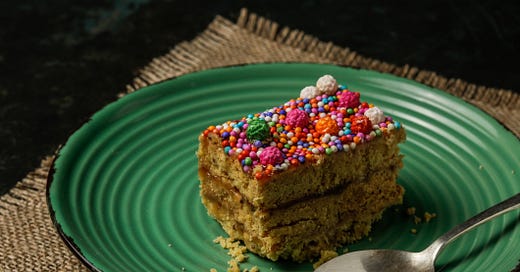It would only be until years after spending my first October in Lima, Peru in 2005 that I would realize how much I have come to associate the month with anise. The liquorice-scented seeds of anise (Pimpinella anisum), an herb from the Middle East and Mediterranean, is lays at the fringes of Peruvian gastronomy, in cookies and cakes that first appeared in convents after Conquest and in the excellent Anis Najar, a digestive liquor from Arequipa that is often used to end a meal there. For much of the year it lingers in the background, but in October, el Mes Morada (the purple month), anise comes front and center.
This is the period of Turrón de Doña Pepa, a layered nougat, drizzled with chancaca (sugarcane syrup) and topped with sprinkles and candy. Industrial versions are now common year round, but it’s only in October and early November where you will find it freshly baked in neighborhood pastelerías (El Trinche has a good run down of the best). There are often big sheet pans of it and pieces are cut off like cake. Or they are packaged into pastry boxes. It’s a variation of a classic Spanish nougat or alba nougat, and has a history that extends back hundreds of years in Peru.
October is when El Señor de Milagros, or the Lord of Miracles, a religious procession that attracts tens of thousands of people is held in the historic center of the city. El Señor de los Milagros is a revered image of Christ painted on a wall by an Angolan slave in the Las Nazarenas Church in the district of Pachacamilla in what is now downtown Lima. As the tale goes, in 1655, a massive earthquake struck Lima and much of the center was left in rubble. Miraculously, the wall of Las Nazarenas where the image of Christ sat was left untouched, even as the rest of the church crumbled around it. People began to worship the image, called Cristo de Pachacamilla, and came from across the country to see it and a chapel was built around it. It was common belief that the image gave protection from earthquakes and could even cure people of grave illnesses.
The origins of how Turrón de Doña Pepa came to be associated with El Señor de Milagros are somewhat murky, with varying accounts of what actually happened, though the the general idea is similar. In the late 1700s, one of those that came to see the image was Josefa Marmanillo, an Afro-Peruvian slave from the Cañete Valley. She allegedly suffered badly from paralysis and ventured to Lima to pray to the image and asked him to cure her. Soon after she was felt better and there were no more pains in her arms and legs. Eternally grateful, she wanted to do something to give back. Some historians have noted that she may have been a noted cook who sold chicha, sango and ñaju on the streets, but in a dream saints are said to have appeared to her and gave her the recipe for turrón, which may have also been created for a competition held by the Viceroy.
Regardless of how and why the recipe was invented, at some point she began walking through the crowds around Las Nazarenas to hand out her recipe with its anise flavored nougat made of wheat flour, butter, and eggs, which was drizzled with chancaca and topped with dried fruits. Each October thereafter she would come to Lima and do the same. Years later, as Marmanillo became more and more identified at the scene of celebration, her nickname Doña Pepa was added, immortalizing her. Every October in Lima, turrón de Doña Pepa is a common sight at the processions and free samples are passed out along Avenida Tacna near the church.
I have been to the procession a few times for the spetacle of it, but it’s this anise flavor I really look forward to. It creeps into the cuisine in places you least expect it. Turrón turns into cheesecakes and ice creams and other sweets. It doesn’t always have much to do with the religious aspect of the event, but just a celebration of something distinctly Peruvian.
Here are how some Peruvian restaurants are celebrating the flavor:
Tanta locations sell take away versions up to a kilo in weight:
At Jarana in New Jersey, chef Jesus Delgado has turned turrón de Doña Pepa into a sundae:
Sold in a Retablo box, El Senorio de Sulco’s turrón is a favorite:
At Central in Lima, they made some for staff meal:
Keep reading with a 7-day free trial
Subscribe to New Worlder to keep reading this post and get 7 days of free access to the full post archives.








